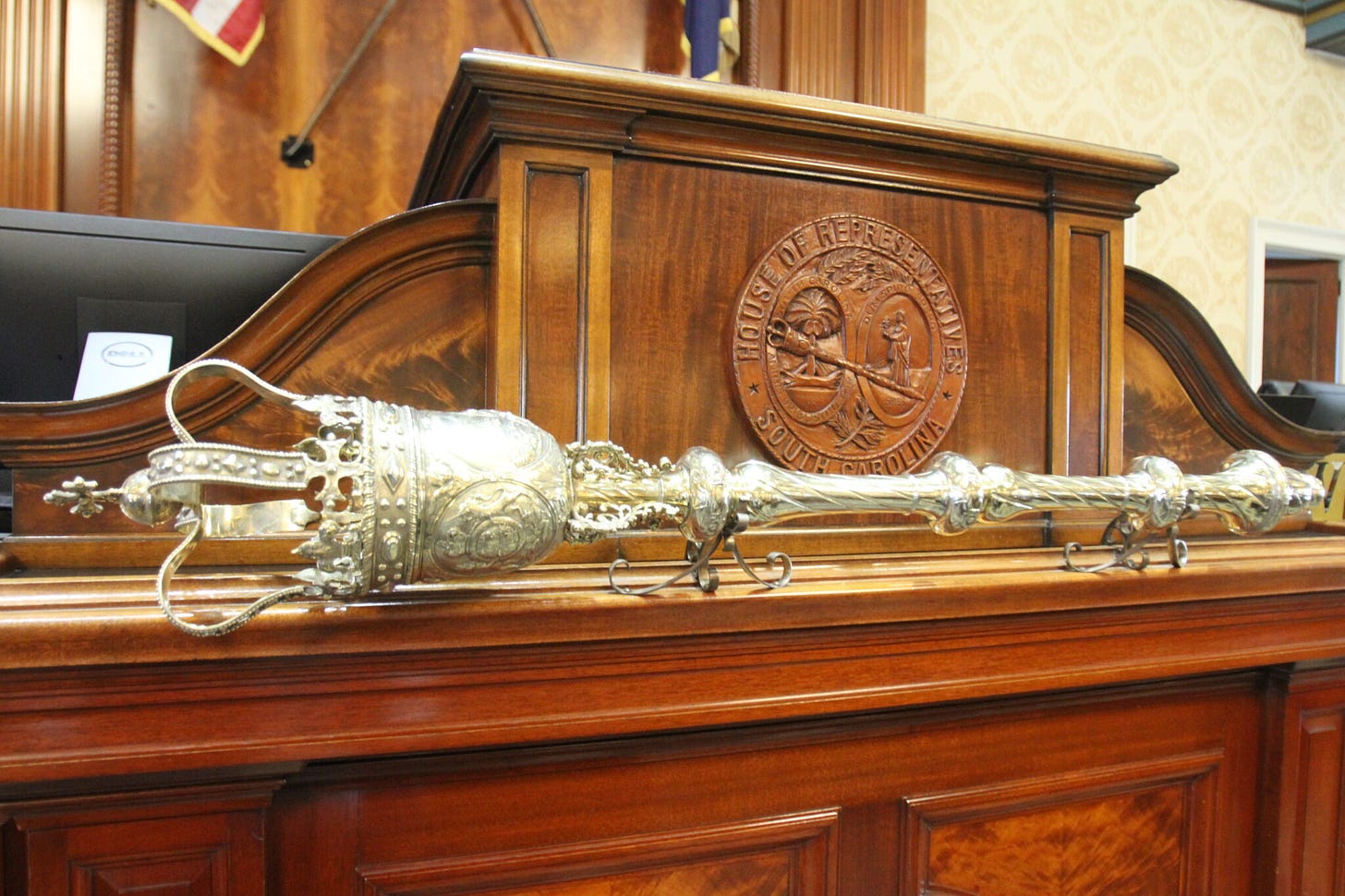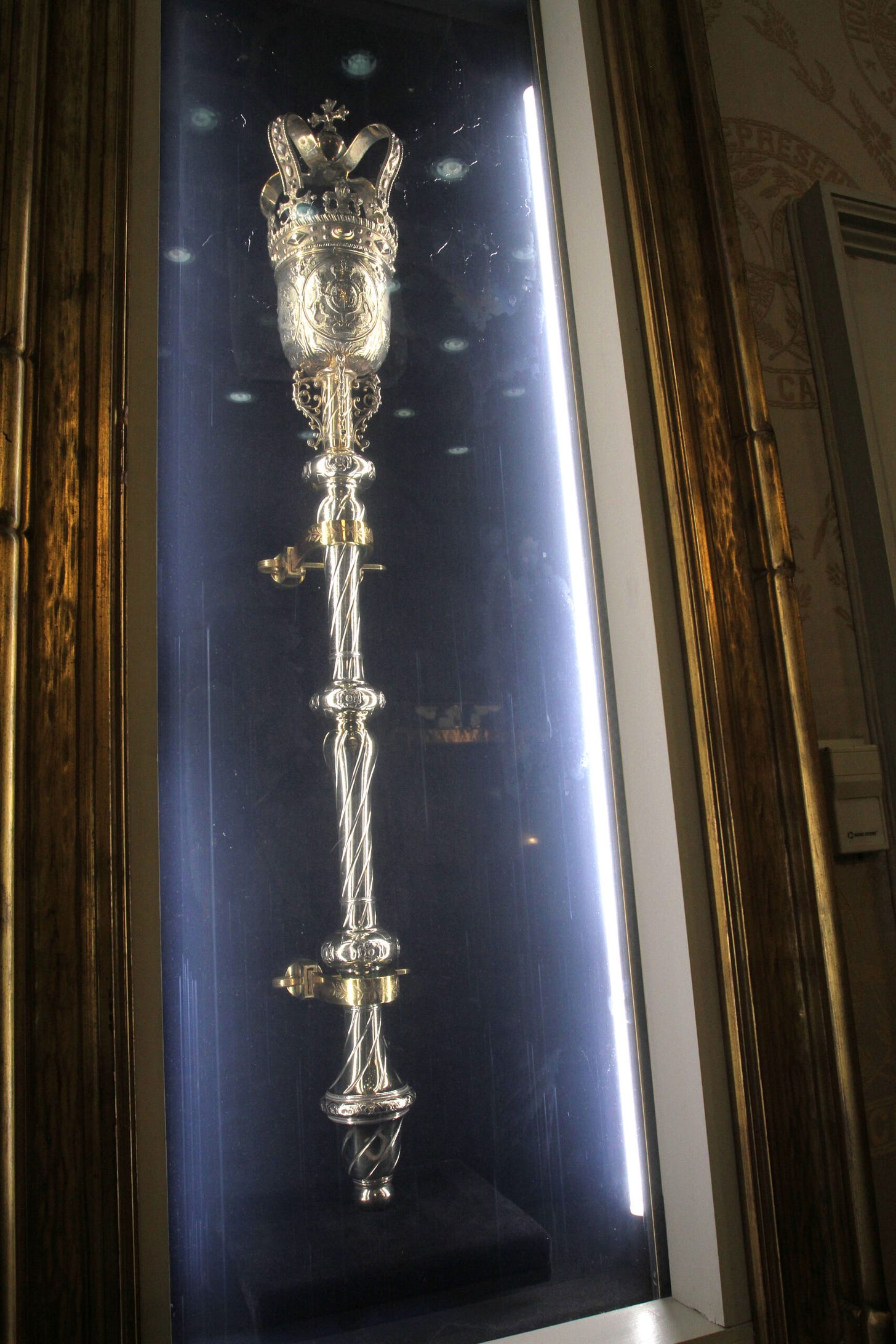#117: South Carolina's Sword of State, Storytelling Festival & Liars Competition, and bio of Eliza Lucas Pinckney
For South Carolina history lovers far and wide! Published weekly on Monday mornings. Enjoy weekly SC history articles, interviews w/ experts, book recommendations, and upcoming SC historical events.
Dear reader,
Welcome to SC History Newsletter #117!
This weekend, my best friend got married in Upstate, NY (peak fall splendor!) and she was the most beautiful bride! It was a wonderful weekend, but alas, I got home to South Carolina late last night and started the newsletter — but am only just not finishing. I hope you can forgive me :)
As always, I’d like to welcome the following new subscribers to our community. Thank you for your interest in South Carolina history!
ashbysanders
mfondren
bettyack
kmcclure
jsummer3
f2gorman
armproductionfr
johndoe134799
theusc
wtkbakj
billray01
marsha01
cosminonlinecanspam
New friends! If you are new to the newsletter, please note that there are over 100 previous SC History newsletters on topics ranging from the founding of Charleston, sunken Confederate submarines, railroad tunnels filled with blue cheese, and so much more! I encourage you to take a look at our archive here.
Send me your topic ideas: I love it when subscribers write to me! Have a SC History topic or question you’d like for me to write about? Just reply to this email and let me know!
Join us on social: Please join us & keep the conversation going by becoming a member of our SC History Newsletter Facebook Community here! I can’t wait to meet you. :)
If your email “cuts off”: In your email app or website, if my emails “cut off” for you, please click the title of the email and it will take you to the full post on the Substack. I don’t want you to miss any content!
And now, let’s learn some South Carolina history!
Yours truly,
Kate
(Writing from Greenville, SC)
➳ Featured SC History Events
Please note our featured SC History Event below, and click here to visit my SC History Events Calendar that organizes all the upcoming SC history events I have discovered.
Please let me know if you’d like to add an event to the calendar! Reply to this email to send me your events.
Event Recommendation of the Week:
October 18-19 | “Storytelling Festival & Liars Competition” | Hagood Mill Historic Site | Pickens, SC | Tickets & information
“Each October, the hills and hollers around the Hagood Mill Historic Site come alive with storytellers sharing the weird and wonderful, mountain funnies, memories of yesteryear, and tales of mystical places in Appalachia. In addition to our fabulous storytellers, eight talented wordsmiths will have eight minutes each to tell their best, their boldest, their funniest and most outlandish lies to be crowned with the title of “Biggest Liar in South Carolina.” Cash prizes will be awarded to first, second, and third place contestants. If you have tall tales, fish stories, alternative facts, or bald-faced bits of balderdash and aren’t afraid to share them, make sure you register for one of the limited spaces!”
➳ SC History Book, Article, & Movie Recommendations
“Eliza Lucas Pinckney: An Independent Woman in the Age of Revolution” by Lorri Glover
Publisher’s description:
“The award-winning biography of Eliza Lucas Pinckney, an innovative, highly regarded, and successful woman plantation owner during the Revolutionary era.
Winner of the Society for Historians of the Early American Republic's James Bradford Biography Prize and the South Carolina Historical Society's George C. Rogers Jr. Book Award.
Eliza Lucas Pinckney (1722–1793) reshaped the colonial South Carolina economy with her innovations in indigo production and became one of the wealthiest and most respected women in a world dominated by men. Born on the Caribbean island of Antigua, she spent her youth in England before settling in the American South and enriching herself through the successful management of plantations dependent on enslaved laborers. Tracing her extraordinary journey and drawing on the vast written records she left behind—including family and business letters, spiritual musings, elaborate recipes, macabre medical treatments, and astute observations about her world and herself—this engaging biography offers a rare woman’s first-person perspective into the tumultuous years leading up to and through the Revolutionary War and unsettles many common assumptions regarding the place and power of women in the eighteenth century."
Have you read this book? Tell us your review! Leave a comment below!
➳ SC History Topic of the Week:
Did you know that South Carolina has an official Sword of State & State Mace? Both of which have been stolen at least once each!
South Carolina has its own “National Treasure” mysteries to be solved! The state has its very own Sword of State, as well as a State Mace.
To set the stage for today’s essay, in my research, I found an interesting quote from a user on Reddit that provides some interesting and amusing context for these objects:
“The sword of state is (as Wikipedia says) ‘used as part of the regalia, symbolizing the power of a monarch to use the might of the state against its enemies, and his or her duty to preserve thus right and peace.’ Which makes it all the more entertaining that this sword, and the crown like mace that goes along with it, are used in state senate within a republic that hasn’t recognized a monarch since 1776. Not only that but these symbols of monarchical power have been repeated stolen and lost for various known and unknown reasons, and that the current sword isn’t the original...”
The current Sword of State is safety secured in the South Carolina State House in Columbia, SC and it serves as a symbol of the state Senate.
South Carolina is the only state in the United States to have a Sword of State.
At the start of each legislative day in the South Carolina Senate, the Sergeant at Arms places the sword in a cradle on the Senate rostrum (or platform) at the front of the president's podium, where it rests whenever the Senate is in session.
The current Sword of State is a gold and steel blade that is 39 inches long. According to the SC State Encyclopedia:
“The blade is etched with sprigs of yellow jessamine [the South Carolina state flower] and has a picture of the state coat of arms on one side. The hilt has a pommel decorated with rosettes, and the grip is wrapped with gold braid. The scabbard is covered in burgundy leather, with brass fittings.”

However, this beautiful blade is not the original Sword of State!
According to the earliest records, the original Sword of State was bought by the Commons House of Assembly — the only elected branch of the colonial government — for the appointed governor in 1704 for 26 British pounds, the equivalent of about $6,000 today. In 1776, after South Carolina first adopted an independent state constitution, “the newly elected president of the Senate was escorted to the chamber by the Charleston sheriff carrying the sword.”
It is unlikely the blade was made locally as specialized blades such as this were typically made in Europe and imported to the Colonies, where the hilt would be added by a local smith.
The Sword of State was not a typically sword, but a “flamberge” (or “flaming”) blade, crafted in a wavy pattern (potentially of German origin) — and it was about 4 feet in length. Total length: 50 in; Blade length: 42in; Hilt length: 8 in.

Why were flamberg blades used? While some suggest the physics of the wavy blade may have helped in battle, historians believe these were likely made for aesthetic purposes. A blade made in a wavy pattern was harder to craft, and thus more expensive. Says Arms-n-armor.com: “Commissioning and wearing a flamboyant sword would therefore have been a mark of distinction, wealth, and taste.”
The “flamboyant” Sword of State was kept in the office of the Governor for many and “was wielded by law enforcement officials during inaugurations and other civic occasions in the English colony.”
After the American Revolution, custody of the sword was transferred from the governor’s office to the South Carolina Senate, where it “hung from the front of the senate rostrum during daily sessions and was carried by the sergeant-at-arms on all state occasions.”
Then, on February 3, 1941, newspaper headlines across the state declared “Senate’s ancient sword vanishes!” Detectives were put on the case, antique & art dealers were notified, and museums put on high alert.
Many theories exist about what happened to the sword. Did a group of tourists conspire to steal it and their ringleader put the sword in his pants? The sword was 4 feet long, but could have been hidden by an overcoat?
Another theory suggests that because of the timing of the theft in 1941 (during WWII) and because the sword was “reminiscent of the flaming sword in Genesis guarding the tree of life” — that perhaps it was stolen by Nazi sympathizers obsessed with the occult. “We’re getting way out there, but there are tons of theories because nobody knows,” said Charles Reid, clerk of the South Carolina House to the SC Daily Gazette in 2023.
In 1944, British Ambassador Lord Halifax learned about the theft of the SC Sword of State and sought to secure a replacement for the Senate. In 1951, Sir Oliver Franks presented the governor with a British-made blade etched with the state seal and yellow jessamine, as described above. The sword remains in use today.

Many hoped the original sword would reappear for South Carolina’s 300th anniversary in 1970, but alas, it did not.
Along with a State Sword, South Carolina also has a ceremonial Mace, which symbolizes the authority of the SC House of Representatives.
According to the SC State House website:
“The Mace was made in London, in 1756, by Magdalen Feline. It was purchased by the "Commons House of Assembly of the Province of South Carolina" for 90 guineas. Around the cylindrical head, below the crown, are four circular decorative panels. The four panels depict art work that is representational of craftsmanship from England, France, Ireland and Germany. Made of solid silver, with gold burnishing, it resembles the Mace of the Common Council of Norwich, England. The Mace weighs about 11 pounds and it is scepter-like in appearance. It is topped with a symbolic royal diadem that was modelled after the Crown of St. Edward. At some point in the fourteenth century the idea of the battle-mace was combined with that of the royal scepter, and the ceremonial mace was conceived.”


The South Carolina State House Historian Emeritus, Mr. A.S. Salley learned that South Carolina’s was “the only Mace in use in the United States that antedates the American Revolution.”
In the diary of Joseph Quincey, Jr. of Massachusetts, on March 19, 1773, he visited the State House (then in Charleston) and saw the Mace. He declared it "a very superb and elegant one," that resided on the table before the Speaker.
The Mace has disappeared not once, but twice in South Carolina’s history.
During the Revolutionary War, the Mace was hidden out of fear that Loyalists in Charleston — then the state capital — would steal it. “It was hidden so well, the people who hid it either died or forgot where it was” said Charles Reid, clerk of the South Carolina House.
The Mace resurfaced in 1819, after former Charleston Congressman Langdon Cheves became president of the Second National Bank of the U.S. and “found it in a vault in Philadelphia.”
The Mace was stolen once again on February 4, 1971. The state police and FBI swiftly began investigating the case after the theft occurred.
The FBI recovered the State Mace 3 weeks later in Gainesville, Florida. It was in the possession of Charles C. Norton, the former chief security guard at the State House! Norton was charged with housebreaking and grand larceny. Norton plead guilty and served 3 years in prison.
Since 1998, when the Legislature moved back into the Columbia Statehouse following a renovation, the mace has rested “in a bombproof, bulletproof glass safe on the back wall of the House. A key and combination are needed to access it.”

The original Sword of State still hasn’t been found. At one point a Columbia, SC, a businessman named Julian Wilson (son of U.S. congressman Joe Wilson) offered a $100,000 reward for the sword’s return.
The FBI still has the sword on its website as a “Stolen Art File”
Historian Nic Butler believes that with the power of the internet, we can crack the case of the stolen Sword of State in our lifetime.
Information about the sword can be submitted to the FBI's tipline.
We’ll close with a quote from Charles Reid, clerk of the South Carolina House, also said to the 2023 South Carolina Daily Gazette article:
“South Carolina has a history unlike any other state. It’s a history of so many highs and so many lows that it’s important to remember that there are some symbols that still tie us to who we were and will hopefully take us on to who we’re becoming.”
Have you seen the SC Sword of State and Mace in person at the State House? Tell us about your experience!
➳ Sources — SC’s Role in the US Constitution
"Flame-Bladed Swords: Why?" Arms & Armor, https://www.arms-n-armor.com/blogs/news/flame-bladed-swords-why. Accessed 14 Oct. 2024.
"Have You Seen South Carolina’s Missing Sword?" Courthouse News, https://www.courthousenews.com/have-you-seen-south-carolinas-missing-sword/. Accessed 14 Oct. 2024.
"South Carolina’s Sword of State Missing for More Than 70 Years." Greenville News, 31 Dec. 2013, https://www.greenvilleonline.com/story/news/local/south-carolina/2013/12/31/scs-sword-of-state-missing-for-more-than-70-years/4263199/. Accessed 14 Oct. 2024.
"South Carolina Sword of State." FBI Art Crimes, https://artcrimes.fbi.gov/nsaf/south-carolina-sword-of-state. Accessed 14 Oct. 2024.
"South Carolina’s Sword of State Missing for More Than 70 Years." Post and Courier, https://www.postandcourier.com/archives/s-c-s-sword-of-state-missing-for-more-than/article_03e6ddab-656c-504b-b0e1-2c0f42c64496.html. Accessed 14 Oct. 2024.
"Theft of SC Symbol of Power Remains a Mystery 82 Years Later." SC Daily Gazette, 5 Dec. 2023, https://scdailygazette.com/2023/12/05/theft-of-sc-symbol-of-power-remains-a-mystery-82-years-later/. Accessed 14 Oct. 2024.
"Wielding the Sword of State in Early South Carolina." Charleston Time Machine, Charleston County Public Library, https://www.ccpl.org/charleston-time-machine/wielding-sword-state-early-south-carolina. Accessed 14 Oct. 2024.
"Sword of State." South Carolina Encyclopedia, https://www.scencyclopedia.org/sce/entries/sword-of-state/. Accessed 14 Oct. 2024.
"State Seal of South Carolina." South Carolina Legislature, https://www.scstatehouse.gov/studentpage/coolstuff/seal.shtml. Accessed 14 Oct. 2024.
I always want to improve my work. Answer the poll below to give me your review of today’s newsletter. I also welcome your suggestions for new content! Simply reply to this email with your ideas. Thank you!














